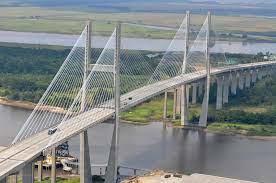
Section Branding
Header Content
New State Contracting Option Could Ease Talmadge Bridge Project
Primary Content

Transportation planners may be able to use legislation the General Assembly passed recently originally aimed at freight rail to make more room for large cargo ships calling at the Port of Savannah.
A bill lawmakers approved on the last day of this year’s legislative session authorizes the state to seek private investment to help finance improvements to Georgia’s freight-rail network.
But provisions the state Senate tacked onto a measure that originated in the Georgia House of Representatives add a new dimension.
Besides the freight rail piece, the final version of the bill would give the state Department of Transportation a new method of contracting for major projects the agency could use to raise the Talmadge Bridge to accommodate a new generation of huge containerized-cargo ships calling increasingly at the port’s Garden City Terminal.
“We know what we’d like to achieve is the raise the bridge,” Georgia Commissioner of Transportation Commissioner Russell McMurry said Friday. “The question is how much and how do you do it?”
The underlying freight rail component of the bill, now on its way to Gov. Brian Kemp’s desk, stems from two years of work by the Georgia Freight & Logistics Commission, a panel of lawmakers, local elected officials, business leaders and logistics industry executives.
The commission reported the state needs up to $1.5 billion a year to move growing volumes of freight smoothly through Georgia.
The bill dedicates the state’s 4% sales tax on diesel fuel used in locomotives to freight rail projects, but that would only generate $4 million to $5 million a year.
To start drawing down the rest, the legislation authorizes the state to enter into public-private partnerships with the freight rail industry, a model that is proving successful in building a network of toll lanes in metro Atlanta.
Rail companies would be allowed to help finance projects that have been deemed of benefit to the public.
Seth Millican, executive director of the Georgia Transportation Alliance, an affiliate of the Georgia Chamber of Commerce, said additional rail sidings and grade separations at rail crossings would qualify as public benefits because they would improve safety and ease traffic flow.
“Particularly in rural communities, you have the issue of blocked crossings,” he said. “If you’ve been stuck trying to get your kids to school or to a doctor’s appointment, there’s a pretty practical implication.”
Millican said the need to improve Georgia’s freight rail network has grown more acute during the coronavirus pandemic, which has caused e-commerce to explode.
“We’re seeing a dramatic increase in people transitioning from shopping in stores to e-commerce,” he said. “It’s an overwhelming change in spending habits.”
The pandemic also has contributed to strong growth at the Port of Savannah, encouraging transportation planners to think about raising the Talmadge Bridge, which at its current height hampers the free flow of cargo into and out of the port during high tides.
McMurry said the project is in its earliest stages, with no timetable set or price tag determined. The contracting provisions in the new bill would help the DOT find the answers to those questions, he said.
McMurry said the legislation provides for a “construction manager/general contractor” approach that differs from the DOT’s traditional method of contracting and the design-build model the agency has been using for a few years.
Traditionally, the DOT decides to do a project, receives bids for the work and selects separate contractors to design and build it. Under the design-build model, the agency hires a contractor to both design and build a project.
“This is in the middle,” McMurry explained. “We hire a designer and a contractor to work with the designer as a team. They design the project up to a point at which a decision can be made.”
Once a decision is made to move forward with a project, the DOT either can ask the contracting team for a price to close the deal or can put the project out to bid, the commissioner said.
The construction manager/general contractor approach ran into criticism as it went through the committee review process in the General Assembly.
“The contractor and the department reach an agreement that doesn’t seem to involve any competition,” said Neill Herring, a lobbyist for the Georgia chapter of the Sierra Club. “It’s a seller’s market. … Why couldn’t they have gone through the normal process?”
House Transportation Committee Chairman Rick Jasperse, R-Jasper, defended the measure on the House floor shortly before lawmakers gave it final passage.
“This is in no way a no-bid contracting bill,” he said. “Contractors would not allow that to happen. This is their bread and butter.”
McMurry said the bill contains “guardrails” aimed at preventing the new form of contracting from being used too often. It limits the construction manager/general contractor model from being used for more than two projects in a single fiscal year or more than seven projects during any 10-year period.
McMurry said the Talmadge Bridge project is well suited for the construction manager/general contractor option because the DOT lacks experience with cable bridges.
“That kind of cable bridge is uniquely designed and constructed,” he said. “We would bring in a contractor with expertise in cable construction to work with a designer to say how much we can raise [the bridge] if we can. Until you get into the design with that contractor, you don’t know if it’s truly feasible or not.”
McMurry said if the project is not feasible, the DOT would be able to exit the contract.
While the DOT begins planning whether and how to raise the Talmadge Bridge, the General Assembly has agreed to extend the Freight & Logistics Commission to a third year.
McMurry said the commission will use that time to identify additional sources of revenue to pay for needed upgrades to Georgia’s freight rail network.
“Knowing the case has been made for infrastructure investment that supports freight and logistics, the question is how do you provide the funding?” he said. “What are the opportunities for funding meaningful projects going forward?”
This story comes to GPB through a reporting partnership with Capitol Beat News Service.

